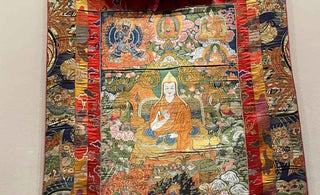
Introduction:
Thangka art is a vibrant and intricate form of Tibetan Buddhist painting that has a rich history and deep spiritual significance. These mesmerizing artworks not only serve as objects of aesthetic beauty but also play a crucial role in storytelling. Thangka paintings are visual narratives that depict mythological tales, historical events, and religious teachings. In this article, we will explore the fascinating world of Thangka art and its connection to storytelling, delving into the narratives of mythology and history that these artworks convey.
The Origin and Significance of Thangka Art:
Thangka art originated in the Tibetan Buddhist tradition and has been practiced for centuries. The word "Thangka" translates to "something that one unrolls" in Tibetan, referring to the scroll-like format of these paintings. The creation of a Thangka involves intricate brushwork, delicate color schemes, and the use of precious materials like gold and natural pigments. These paintings are traditionally executed by skilled artisans who undergo rigorous training to master the techniques and symbolism associated with Thangka art.
Thangka paintings serve as visual aids for practitioners of Tibetan Buddhism, helping them in their spiritual practices and meditative journeys. They depict deities, Buddhas, bodhisattvas, and other divine beings, providing a tangible representation of the enlightened ones. Thangkas are often used as objects of devotion, enabling the viewer to connect with the spiritual realm and deepen their understanding of Buddhist teachings. One particular Thangka pendant that holds significance in this regard is the "Fugen Bosatsu Tibetan Thangka Pendant for Eliminating Ignorance."
The Fugen Bosatsu Tibetan Thangka Pendant is a sacred object of devotion that encapsulates the essence of Fugen Bosatsu, also known as Samantabhadra Bodhisattva. Fugen Bosatsu is revered as the embodiment of universal benevolence, compassion, and wisdom in Mahayana Buddhism. The pendant features a miniature Thangka painting, intricately handcrafted by skilled artisans, depicting Fugen Bosatsu in a vibrant and detailed manner.
This Thangka pendant serves as a powerful tool for practitioners seeking to eliminate ignorance and cultivate wisdom. Ignorance is considered the root cause of suffering in Buddhism, and it is through the cultivation of wisdom that one can transcend this suffering and attain enlightenment. The depiction of Fugen Bosatsu in the pendant serves as a visual reminder and inspiration for practitioners to develop qualities such as compassion, wisdom, and skillful means in their own lives.
The pendant's portability allows practitioners to carry the spiritual energy and symbolism of the Thangka wherever they go. By wearing the pendant, devotees create a constant connection with Fugen Bosatsu, invoking his compassionate presence and guidance throughout their daily activities. It serves as a physical reminder to cultivate wisdom, practice compassion, and engage in virtuous actions, reminding practitioners of the path to liberation and the alleviation of suffering.
The intricate details and symbolism within the Thangka pendant play a crucial role in deepening the understanding of Buddhist teachings. Each element of the painting carries specific meanings and teachings, inviting practitioners to reflect and contemplate on the profound truths encapsulated within the image. The iconography of Fugen Bosatsu, including his mudras (hand gestures), posture, and surrounding motifs, all convey essential aspects of the bodhisattva's enlightened nature and teachings.
By engaging with the Thangka pendant, practitioners are encouraged to cultivate wisdom and eliminate ignorance. The pendant becomes a focal point for meditation and contemplation, allowing practitioners to delve into the depths of their own minds and gain insights into the nature of reality. Through sustained practice, the pendant serves as a catalyst for personal transformation and spiritual growth.
Moreover, the Fugen Bosatsu Tibetan Thangka Pendant acts as a source of inspiration and devotion. Devotees can connect with the compassionate energy of Fugen Bosatsu, seeking his blessings and guidance on their spiritual path. The pendant becomes an object of veneration, inviting practitioners to offer prayers, prostrations, and other acts of devotion as a means of deepening their connection with the enlightened qualities symbolized by Fugen Bosatsu.
Narratives of Mythology in Thangka Art:
One of the primary functions of Thangka art is to depict mythological narratives from Tibetan Buddhist cosmology. These narratives often revolve around the lives and deeds of Buddhas and bodhisattvas, as well as legendary figures from Tibetan folklore. Thangka paintings vividly portray episodes from these myths, allowing viewers to engage with the stories on a visual level.
For example, the Thangka painting of the Wheel of Life, or Bhavachakra, illustrates the cycle of existence and the concept of karma. It depicts the realms of existence, from the heavenly realms to the realms of hell, showcasing the consequences of one's actions. Such narratives serve as moral lessons, reminding viewers of the impermanence of life and the importance of virtuous conduct.
Narratives of History in Thangka Art:
In addition to mythological narratives, Thangka art also portrays historical events and figures. These paintings serve as visual records of significant moments in Tibetan history, preserving cultural heritage and commemorating important figures and events.
For instance, Thangkas may depict scenes from the life of Guru Rinpoche, also known as Padmasambhava, who played a crucial role in the spread of Buddhism in Tibet. These paintings portray Guru Rinpoche's miraculous deeds, his encounters with local deities, and his teachings to the Tibetan people. Through these narratives, Thangka art not only educates viewers about historical events but also fosters a sense of cultural identity and pride.
Conclusion:
Thangka art is a captivating form of Tibetan Buddhist painting that combines aesthetic beauty with storytelling. These intricate paintings serve as visual narratives, conveying mythological tales and historical events to viewers. Through their depictions of gods, goddesses, Buddhas, and historical figures, Thangka paintings offer a glimpse into the rich tapestry of Tibetan mythology and history. They not only serve as objects of devotion and meditation but also inspire contemplation, moral reflection, and a deeper understanding of the Tibetan Buddhist tradition. Thangka art continues to be a cherished art form, preserving and transmitting narratives that have shaped the spiritual and cultural landscape of Tibet for centuries.
























